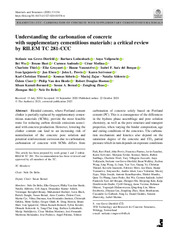Приказ основних података о документу
Understanding the carbonation of concrete with supplementary cementitious materials: a critical review by RILEM TC 281-CCC
| dc.creator | von Greve-Dierfeld, Stefanie | |
| dc.creator | Lothenbach, Barbara | |
| dc.creator | Vollpracht, Anya | |
| dc.creator | Wu, Bei | |
| dc.creator | Huet, Bruno | |
| dc.creator | Andrade, Carmen | |
| dc.creator | Medina Martinez, Cesar | |
| dc.creator | Thiel, Charlotte | |
| dc.creator | Gruyaert, Elke | |
| dc.creator | Vanoutrive, Hanne | |
| dc.creator | F. Sae ´z del Bosque, Isabel | |
| dc.creator | Ignjatović, Ivan | |
| dc.creator | Elsen, Jan | |
| dc.creator | L. Provis, John | |
| dc.creator | Scrivener, Karen | |
| dc.creator | Thienel, Karl-Christian | |
| dc.creator | Sideris, Kosmas | |
| dc.creator | Zajac, Maciej | |
| dc.creator | Alderete, Natalia | |
| dc.creator | Cizer, Ozlem | |
| dc.creator | Van den Heede, Philip | |
| dc.creator | Douglas Hooton, Robert | |
| dc.creator | Kamali-Bernard, Siham | |
| dc.creator | A. Bernal, Susan | |
| dc.creator | Zhao, Zengfeng | |
| dc.creator | Shi, Zhenguo | |
| dc.creator | De Belie, Nele | |
| dc.date.accessioned | 2023-09-26T10:10:10Z | |
| dc.date.available | 2023-09-26T10:10:10Z | |
| dc.date.issued | 2020 | |
| dc.identifier.issn | 1359-5997 | |
| dc.identifier.issn | 1871-6873 | |
| dc.identifier.uri | https://grafar.grf.bg.ac.rs/handle/123456789/3159 | |
| dc.description.abstract | Blended cements, where Portland cement clinker is partially replaced by supplementary cementitious materials (SCMs), provide the most feasible route for reducing carbon dioxide emissions associated with concrete production. However, lowering the clinker content can lead to an increasing risk of neutralisation of the concrete pore solution and potential reinforcement corrosion due to carbonation.carbonation of concrete with SCMs differs from carbonation of concrete solely based on Portland cement (PC). This is a consequence of the differences in the hydrate phase assemblage and pore solution chemistry, as well as the pore structure and transport properties, when varying the binder composition, age and curing conditions of the concretes. The carbonation mechanism and kinetics also depend on the saturation degree of the concrete and CO2 partial pressure which in turn depends on exposure conditions (e.g. relative humidity, volume, and duration of water in contact with the concrete surface and temperature conditions). This in turn influence the microstructural changes identified upon carbonation. This literature review, prepared by members of RILEM technical committee 281-CCC carbonation of concrete with supplementary cementitious materials, working groups 1 and 2, elucidates the effect of numerous SCM characteristics, exposure environments and curing conditions on the carbonation mechanism, kinetics and structural alterations in cementitious systems containing SCMs. | sr |
| dc.language.iso | en | sr |
| dc.publisher | Springer | sr |
| dc.rights | openAccess | sr |
| dc.rights.uri | https://creativecommons.org/licenses/by-nc-nd/4.0/ | |
| dc.source | Materials and Structures | sr |
| dc.subject | Carbonation | sr |
| dc.subject | Supplementary cementitious materials | sr |
| dc.subject | Aggregate | sr |
| dc.subject | Environmental impact | sr |
| dc.subject | Transport properties | sr |
| dc.title | Understanding the carbonation of concrete with supplementary cementitious materials: a critical review by RILEM TC 281-CCC | sr |
| dc.type | article | sr |
| dc.rights.license | BY-NC-ND | sr |
| dc.citation.issue | 136 | |
| dc.citation.rank | M21 | |
| dc.citation.volume | 53 | |
| dc.identifier.doi | 10.1617/s11527-020-01558-w | |
| dc.identifier.fulltext | http://grafar.grf.bg.ac.rs/bitstream/id/11949/s11527-020-01558-w.pdf | |
| dc.type.version | publishedVersion | sr |

